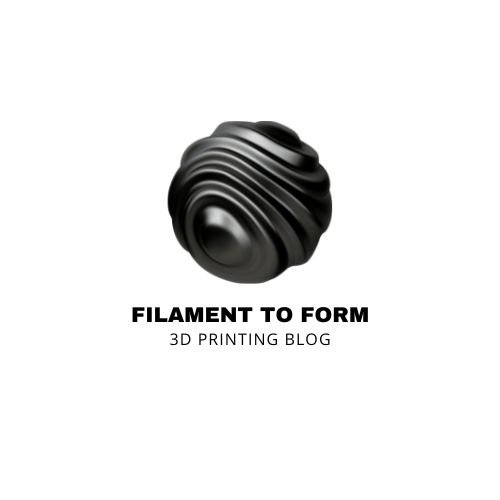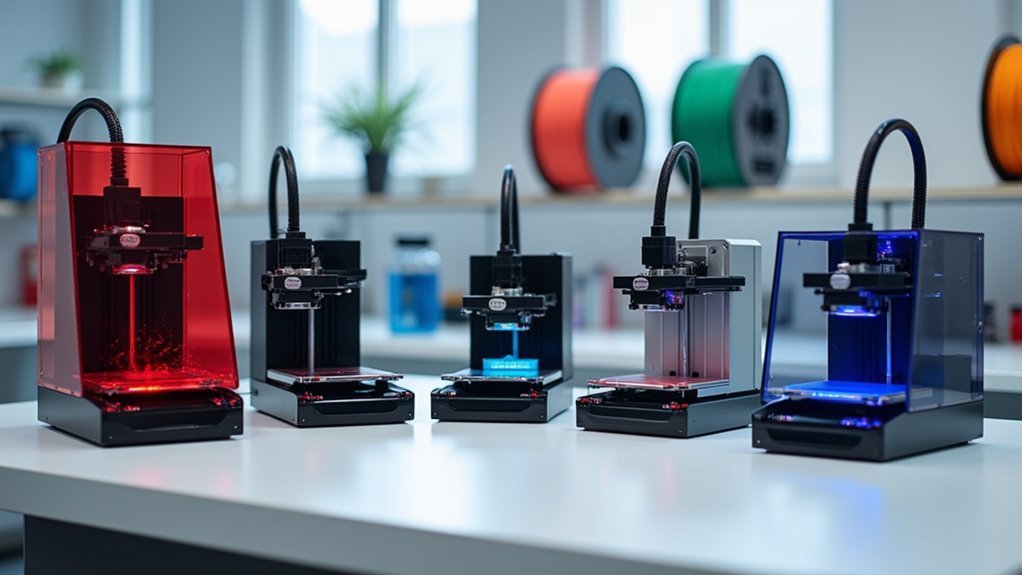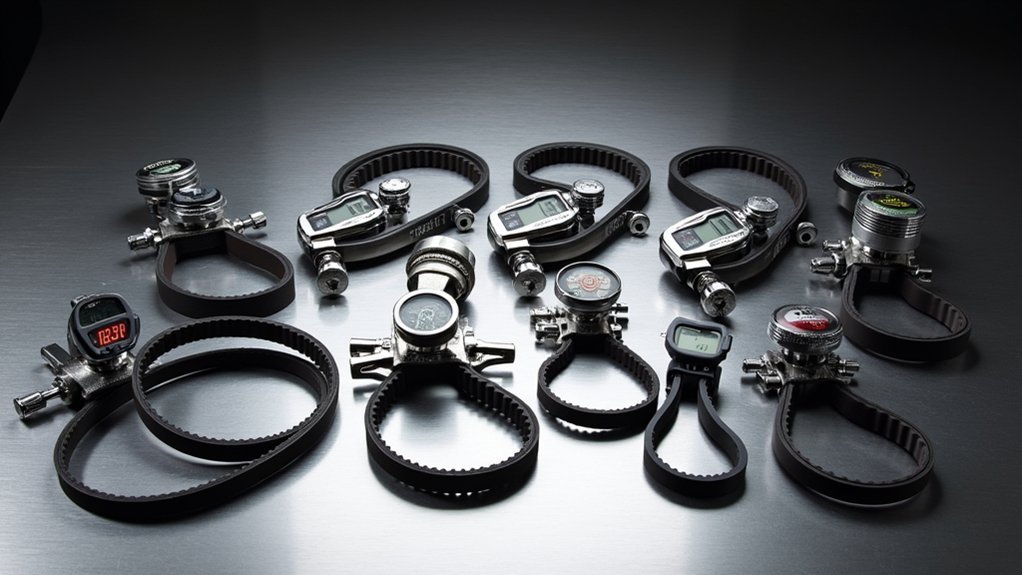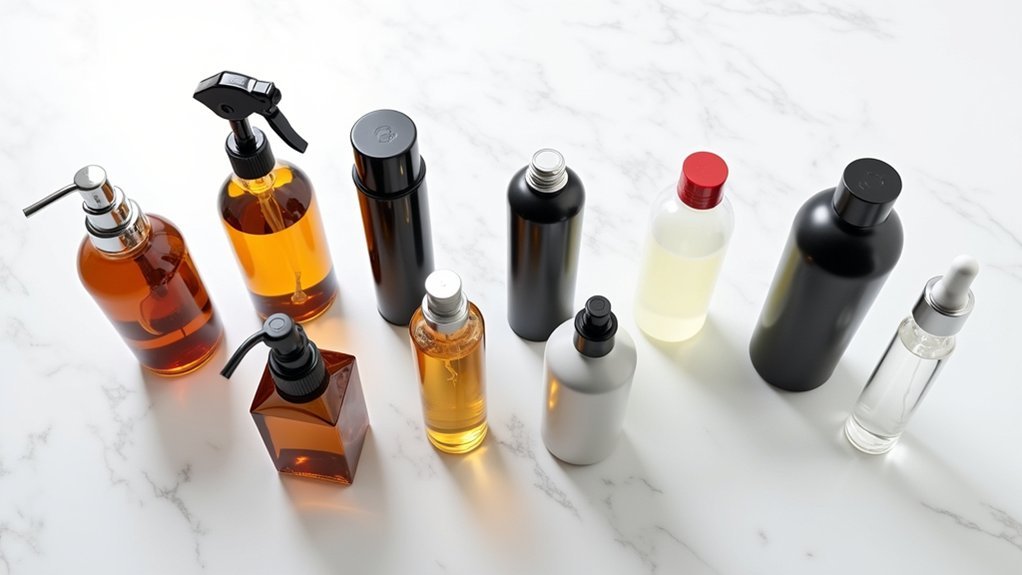You’ve probably experienced the frustration of failed prints due to poor bed leveling – it’s one of the most common issues that’ll derail your 3D printing projects before they even begin. While manual leveling can work, it’s time-consuming and often inconsistent. Auto-leveling sensors promise to solve this problem, but not all deliver on their claims. The key is knowing which models actually provide reliable, consistent results that’ll transform your printing experience.
Creality CR Touch Auto Bed Leveling Sensor Kit for 3D Printer
Although manual bed leveling can frustrate even experienced 3D printing enthusiasts, the Creality CR Touch Auto Bed Leveling Sensor Kit transforms this tedious process into an automated convenience for Ender and CR-10 series printer owners. You’ll appreciate its metal probe tip’s durability—it’s rated for over 100,000 uses. The sensor performs multi-point detection, recording each platform height for enhanced print quality. However, you’ll still need manual leveling before initial use, and firmware installation can challenge beginners. With 4.3-star ratings from 1,621 users, this upgrade greatly improves your printing experience, though you should prepare for calibration adjustments and potential firmware complications.
Best For: Ender and CR-10 series 3D printer owners who want to automate the bed leveling process and improve print quality, but are prepared to handle firmware installation and calibration challenges.
Pros:
- Durable metal probe tip rated for over 100,000 uses with stable quality and long service life
- Significantly improves print quality through automated multi-point detection and height recording
- High customer satisfaction with 4.3-star rating from over 1,600 users and strong sales ranking
Cons:
- Firmware installation can be challenging for beginners and may cause printer recognition issues
- Still requires manual bed leveling before initial use and ongoing calibration adjustments for optimal performance
- Some users report inconsistent bed leveling results and compatibility issues with specific mainboard versions
Creality CR Touch Auto Leveling Kit for 3D Printers
The Creality CR Touch Auto Leveling Kit transforms your manual 3D printing experience into an automated workflow, making it an ideal upgrade for Ender and CR-10 series owners who want consistent first layers without constant bed adjustments.
You’ll receive everything needed for installation, including the sensor, five 0.4mm nozzles, mounting brackets, and hardware. The kit performs multi-point detection across your print surface, creating a virtual compensation plane that works with PEI, glass, sticker, and metal beds.
Installation requires firmware updates from Creality’s website, which you’ll rename to 123.bin before updating via SD card. While users rate it 4.4/5 stars, some report installation challenges and firmware issues, particularly with certain Ender 3 Pro models, so verify compatibility first.
Best For: 3D printer enthusiasts with compatible Ender or CR-10 series printers who want to eliminate manual bed leveling and achieve consistent first layers with minimal ongoing adjustments.
Pros:
- Multi-point detection system creates precise virtual compensation plane that works with various bed surfaces including PEI, glass, and metal
- Complete kit includes all necessary components (sensor, nozzles, brackets, hardware) for installation
- Durable design rated for over 100,000 uses with strong user satisfaction (4.4/5 stars from 973 reviews)
Cons:
- Installation can be challenging with unclear instructions and complex firmware update requirements
- Some users experience firmware crashes, Z-axis offset issues, and compatibility problems especially with certain Ender 3 Pro models
- Poor customer support from Creality when troubleshooting problems or technical issues arise
Upgraded Tina2S 3D Printer, HEPHI3D WiFi Cloud Printing with Auto Bed Leveling
When you’re seeking an affordable entry point into 3D printing without sacrificing essential features, HEPHI3D’s Upgraded Tina2S stands out as a compact powerhouse designed specifically for beginners. This fully assembled mini printer measures just 8.26 x 8.26 x 11.4 inches and weighs 5.72 pounds, making it perfect for limited spaces.
You’ll appreciate the dual X/Y/Z-axis auto-leveling system that eliminates tedious manual adjustments. The Poloprint Cloud app enables one-click slicing with WiFi connectivity, while the ultra-quiet operation runs at only 40-50dB. The PEI spring steel magnetic platform heats to 60°C, preventing warping and ensuring quality prints.
Despite occasional filament jamming issues, the 12-month warranty and responsive customer support make this an excellent starter choice.
Best For: Beginners, teens, and hobbyists looking for an affordable, compact 3D printer with automated features and WiFi connectivity for small-space setups.
Pros:
- Dual X/Y/Z-axis auto-leveling system eliminates manual bed adjustments for hassle-free setup
- Ultra-quiet operation at 40-50dB with WiFi cloud printing through the Poloprint app
- Comprehensive warranty package including 12-month free repair and lifetime technical support
Cons:
- Frequent filament jamming issues reported by users after initial use periods
- Noise levels may still be problematic for overnight printing despite quiet operation claims
- Limited print quality compared to higher-end models, requiring upgrades for advanced users
E-Leveler 2 – The Original 3D Printer Electronic Bed Leveling Tool
Manual bed leveling becomes a breeze when you’re equipped with the E-Leveler 2, Chuck Hellebuyck’s original electronic bed leveling tool featured on Filament Friday YouTube channel. You’ll appreciate the LED light that provides visual feedback during adjustments and the simplified nozzle target that makes leveling easier. The improved design includes a stronger battery holder for durability, bed adjustment reminder arrows for guidance, and plastic end caps that act as stabilizing legs. You can use this tool with most 3D printers that have manually adjustable beds, though it won’t work with resin or Delta printers. You’ll achieve perfectly level beds and improved print quality efficiently.
Best For: 3D printer enthusiasts and hobbyists who use FDM printers with manually adjustable beds and want to achieve consistently level print surfaces for improved print quality.
Pros:
- LED visual feedback and simplified nozzle target make the bed leveling process intuitive and efficient
- Improved design features including stronger battery holder, guidance arrows, and stabilizing legs enhance durability and ease of use
- Compatible with most manually adjustable 3D printer beds, providing a versatile solution for better print quality
Cons:
- Limited compatibility as it cannot be used with resin printers or Delta printers
- Requires manual bed adjustment capability, excluding printers with automatic bed leveling systems
- Depends on battery power which may need periodic replacement or charging
Creality CR Touch Auto Leveling Sensor for 3D Printers
If you’re seeking precision without the hassle of constant manual adjustments, Creality’s CR Touch Auto Leveling Sensor delivers ultra-sensitive 0.01mm resolution that transforms your printing experience. This compact 11.5g sensor achieves <0.04mm positioning accuracy through multi-point detection, creating a virtual plane that automatically compensates for platform tilt. You'll appreciate its metal probe construction that withstands 100,000+ detection cycles while consuming 35% less energy than standard levelers. Compatible with popular Ender-3 and CR-10 models, it works seamlessly across PEI, glass, and metal surfaces. Installation's straightforward—simply download the program, copy to your SD card, and you're ready.
Best For: 3D printing enthusiasts and professionals who want to eliminate manual bed leveling and achieve consistent first-layer quality across multiple prints with minimal setup effort.
Pros:
- Ultra-precise 0.01mm resolution sensor with <0.04mm positioning accuracy ensures consistent bed leveling across the entire print surface
- Durable metal probe construction rated for 100,000+ detection cycles while consuming 35% less power than standard auto-levelers
- Easy installation process with broad compatibility across popular Ender-3 and CR-10 printer models and various bed surfaces
Cons:
- Limited compatibility restricts use to specific Creality printer models, excluding older or non-Creality machines
- Requires firmware updates and SD card installation which may intimidate beginners unfamiliar with 3D printer modifications
- Additional hardware component adds another potential failure point and increases overall printer complexity
Factors to Consider When Choosing 3D Printers Auto-Leveling Sensors That Actually Work
When you’re selecting an auto-leveling sensor for your 3D printer, you’ll need to verify it’s compatible with your specific printer model and understand the installation and firmware requirements involved. You should also evaluate the sensor’s detection accuracy and precision, as these directly impact your print quality and bed leveling reliability. Don’t overlook durability, service life, and power consumption since these factors affect long-term performance and operational costs.
Compatibility With Printer Models
One of the most critical factors you’ll encounter is ensuring your chosen auto-leveling sensor works seamlessly with your specific printer model. Many sensors are engineered exclusively for certain 3D printer versions, making compatibility research essential before purchasing.
Check your printer’s mainboard version carefully, as some sensors require specific configurations like 32 Bit V4.2.2 or V4.2.7 to function properly. You’ll also want to verify the sensor’s specifications confirm compatibility with your print bed materials, whether you’re using PEI, glass, or metal surfaces.
Consider sensors that support multiple printer models for future versatility. Don’t skip reading user reviews, as they’ll reveal real-world compatibility issues and performance variations across different printer models and firmware configurations.
Installation and Firmware Requirements
Installation complexity varies dramatically across different auto-leveling sensors, and you’ll need to carefully evaluate both the mechanical setup and firmware requirements before making your purchase. Most sensors require firmware downloads and updates, which can prove challenging if you can’t identify the correct version for your printer’s mainboard. You’ll receive installation components like mounting brackets, screws, and guides, though clarity varies greatly between products.
Following online tutorials, especially YouTube videos, helps avoid common installation pitfalls during mechanical setup and firmware updates. You’ll likely need to perform manual bed leveling before activating auto-leveling features, plus fine-tune Z-offset settings for ideal performance. Ensuring compatibility between your printing surface materials and firmware versions is essential—misalignment causes functionality issues and inconsistent leveling results.
Detection Accuracy and Precision
Detection accuracy determines whether your auto-leveling sensor delivers consistent, reliable results or becomes a source of frustration during every print job. You’ll want sensors achieving positioning accuracy below 0.04mm for precise adjustments that translate into professional-quality prints.
Look for multi-point detection capabilities that record measurements across your entire printing platform. This creates a virtual plane enabling automatic compensation for surface irregularities you can’t see with the naked eye.
Ultra-sensitive sensors with 0.01mm resolution provide the finest leveling precision available. You’ll also need consistent performance over time – choose sensors rated for 100,000+ detection cycles without accuracy degradation.
Remember that even premium auto-leveling systems may require occasional calibration adjustments. Manual bed leveling can help maintain excellent print quality and address detection discrepancies.
Durability and Service Life
Since your 3D printer’s auto-leveling sensor will endure thousands of probing cycles throughout its lifetime, investing in a durable unit saves you money and eliminates costly downtime. Choose sensors rated for over 100,000 uses to guarantee long-term reliability during continuous operation. Metal probe tips greatly outperform plastic alternatives, offering superior wear resistance and extended service life under repeated contact with print beds.
Ultra-sensitive technology with high resolution not only improves accuracy but also reduces replacement frequency by maintaining consistent performance longer. Low-power IC chips consume less energy, contributing to overall sensor efficiency and longevity. Don’t overlook installation simplicity—complicated setups often lead to improper usage and premature component wear, ultimately shortening your sensor’s lifespan and increasing maintenance costs.
Power Consumption and Efficiency
Three critical power-related factors determine your auto-leveling sensor’s operational efficiency and long-term performance costs. First, you’ll want sensors consuming less than 1 watt of power, which guarantees energy-efficient operation without compromising your printer’s overall performance. Advanced sensors with low-power integrated circuits can reduce energy consumption by up to 35% compared to standard models, translating to lower operational costs and extended sensor lifespan through reduced thermal stress.
Second, consider sensors designed for peak performance below 65°C operating temperatures. This guarantees stable functionality without excessive energy draw. Third, prioritize lower power consumption for continuous usage scenarios, as reduced consumption generates less heat and prevents potential issues during prolonged operations. These efficiency gains directly impact your printing costs and equipment longevity.
Frequently Asked Questions
How Often Do Auto-Leveling Sensors Need Calibration or Maintenance?
You’ll need to calibrate auto-leveling sensors every 20-50 prints or monthly, depending on usage. Clean the sensor weekly, check for debris buildup, and recalibrate after moving your printer or changing build surfaces.
Can Auto-Leveling Sensors Work With All Types of Print Bed Surfaces?
You’ll find auto-leveling sensors don’t work universally with all bed surfaces. Inductive sensors need metal beds, while capacitive and BLTouch sensors handle glass, PEI, and other materials better, requiring specific sensor types for ideal performance.
Do Auto-Leveling Sensors Significantly Slow Down the Printing Process?
Auto-leveling sensors don’t considerably slow your printing process. You’ll spend 2-5 minutes on bed leveling before each print, but this replaces manual leveling that’d take much longer and reduce print quality.
What Happens if the Auto-Leveling Sensor Fails During a Print Job?
If your auto-leveling sensor fails mid-print, you’ll likely experience adhesion problems, warping, or complete print failure. Most printers won’t detect the malfunction immediately, so you’ll waste filament and time.
Are Auto-Leveling Sensors Compatible With Heated Beds Above 100°C?
You’ll find most auto-leveling sensors work fine with heated beds above 100°C, but you should check your specific sensor’s temperature rating. Inductive sensors typically handle higher temps better than capacitive ones.





Leave a Reply